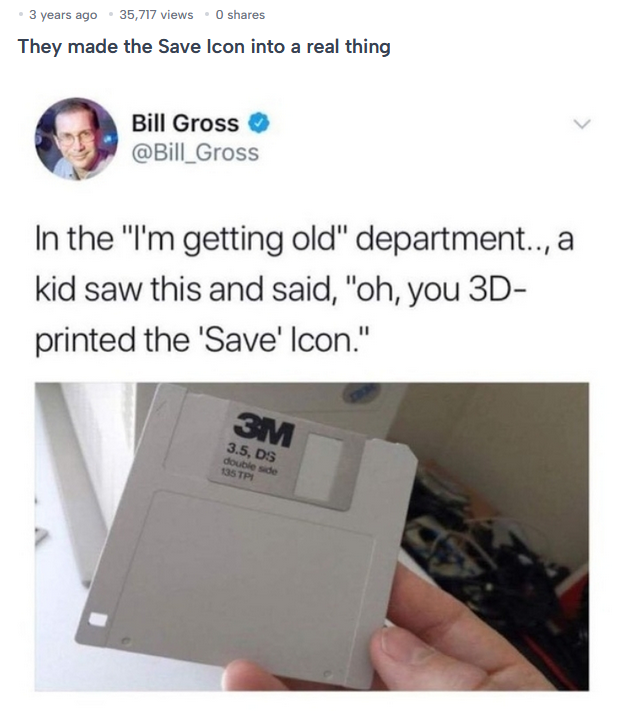There’s this post that I came across while scrolling on Instagram, and it definitely comes back to me every now and then1:

It’s one of those tiny, perfect internet moments, It’s funny at first, a neat little snapshot of generational disconnect, but the more you think about it, the more it feels like a perfect metaphor for how digital culture eats its own history.
And that got me thinking: where in the world is the floppy disk, really?
It’s such a strange question, but it fits. The floppy disk has literally vanished from the physical everyday world, its been banished to the dusty boxes in attics, and yet somehow it’s still everywhere. It’s now an icon, there every time you save a document or screenshot. It’s sitting in the corner of your screen, patiently doing its job, even though the thing it represents has been out of sight for decades. And out of sight is out of mind, right?
In the 1980s, that small piece of plastic had meaning because it did something. It physically stored your work. When early computer designers chose it as an icon, they were using the logic of representation: this image stands for that action. But somewhere along the way, the relationship flipped. The icon outlived the reality. We now use the symbol to represent an idea that no longer depends on the original thing.
And honestly, that’s kind of amazing.
The floppy disk has transcended its own existence. It’s become pure metaphor, so much so that now, people are starting to forget what it ever was in the first place.
And it reminds me of something we read about in one of our lecture:
Baudrillard describes a world in which the distinction between real and imaginary, copy and original, no longer holds. ‘It is no longer a question’, he writes, ‘of imitation, nor duplication, nor even parody. It is rather a question of substituting signs of the real for the real’2
(Baudrillard, 1994: 2).
Baudrillard might call this the third order of simulacra, when a sign no longer masks reality but replaces it entirely. The floppy disk icon doesn’t hide the absence of the real floppy; it functions just fine without it. It doesn’t need the physical referent to mean “save.” It has become what Baudrillard would describe as hyperreal, more real than real.
And that’s what makes the tweet so fun to think about for me. When the kid says “you 3D-printed a save icon,” they’re not wrong. They’re just living fully inside that now hyperreality. In their world, the save icon is the original. They’re seeing the simulation as the real thing, because for them, it is.
This, in a strange way I feel, is the story of digital culture itself. The internet is full of objects that have shed their physical origins but continue to exist as pure symbols. We send envelopes to deliver emails. We tap on phones shaped like old receivers. We scroll through “files” that exist nowhere and everywhere at once. Our entire interface with the digital world is built from relics of vanished technologies, each one a simulacrum of something that no longer exists.
The floppy disk icon is like a shared cultural fossil, a memory so deeply encoded in the design language of computing that we can’t get rid of it, even if we wanted to.
While reading about this post, i found that there are Reddit and Quora threads full of people debating what could replace it:
“Since so many younger people don’t know what a floppy disk is, what should replace the save icon?”3 The answers are fascinating. Some people suggest a cloud, since that’s where we all store our files now. Others propose a downward arrow, like the download button, something simple and literal. A few even argue that we don’t need a “save” icon anymore because our devices save everything automatically. In other words, maybe the concept of saving itself is outdated.
Over on Reddit4, the discussion gets even more philosophical. One commenter brought up that we don’t save anymore, we just stop editing. Another said the floppy disk stays because no one wants to re-train billions of users. That’s probably true. Once an icon becomes universal, changing it is almost impossible. The floppy disk stuck around because it works. Everyone knows what it means now, even if they have no idea what it is.
So, where in the world is the floppy disk? It’s hiding in plain sight, in your apps, your browser tabs, your productivity tools. It’s alive as an idea, embedded in the language of digital life. It’s everywhere and nowhere at once.
That’s what makes the tweet so funny and a little bit poignant. One person sees nostalgia; another sees a 3D-printed digital icon. Both are right. The floppy disk has stopped being a piece of technology and started being a piece of culture. It’s become something we inherit rather than remember.
And maybe that’s the natural order of things online. Every generation misinterprets the symbols it inherits, and in doing so, gives them new life. Someday, a kid will probably ask why the “call” icon looks like a weird boomerang, or why “email” uses an envelope.
We’ll just have to wait and see.
- https://programmerhumor.io/programming-memes/they-made-the-save-icon-into-a-real-thing/ ↩︎
- [Baudrillard, J. (1994) Simulacra and Simulations, trans. S. F. Glaser, Ann Arbor: University of Michigan Press] cited in [Matthew Potolsky, Mimesis. New York: Routledge, 154] ↩︎
- https://www.quora.com/Since-many-in-the-younger-generation-do-not-know-what-a-floppy-disk-is-yet-a-floppy-disk-remains-the-standard-save-icon-on-many-computers-what-might-be-a-better-save-icon-for-the-current-generation ↩︎
- https://www.reddit.com/r/technology/comments/by894/how_much_longer_would_a_35_floppy_be_the_save_icon/?
https://www.reddit.com/r/UI_Design/comments/sn9qt8/what_symbol_could_replace_the_floppy_disk_as_the/? ↩︎


Recent Comments